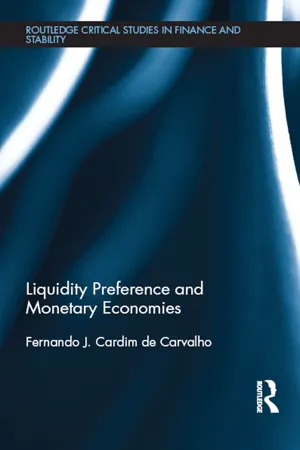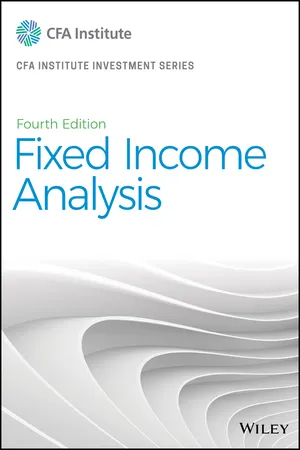Economics
Liquidity Premium Theory
The Liquidity Premium Theory is an economic concept that suggests investors require a premium, or higher return, for holding assets with lower liquidity. This theory posits that investors are willing to accept lower returns on more liquid assets, and demand compensation in the form of a liquidity premium for investing in less liquid assets.
Written by Perlego with AI-assistance
Related key terms
Related key terms
1 of 4
Related key terms
1 of 3
6 Key excerpts on "Liquidity Premium Theory"
- eBook - ePub
- Jagdish Handa(Author)
- 2002(Publication Date)
- Routledge(Publisher)
(3) will be modified to:Equation (5) is known as the liquidity preference hypothesis of the yield curve. For a more specific hypothesis on liquidity preference, designating the liquidity premium as t γt+n , we have:where ∂γn /∂n ≥ 0 by virtue of the liquidity premium, and:γ liquidity premiumρ degree of risk aversionγ liquidity premium ρ degree of risk aversionWe can distinguish between two versions of (6) on the basis of two alternative assumptions on the liquidity premium. These are as follows.(i) The liquidity premium is constant per period such that t γt+i = i γ, where γ is a constant. While there is no particular intuitive justification for making this assumption, it is analytically convenient and, as seen later in this chapter, is made in many empirical studies. It reduces (6) to:Equation (7) with a constant per-period risk premium is sometimes called the strong form of the expectations hypothesis.(ii) The per-period liquidity premium varies with the term to maturity and, moreover, may not be constant over time, for example, over the business cycle, so that (6) does not simplify to (7) . This is sometimes called the weak - eBook - ePub
Market Consistency
Model Calibration in Imperfect Markets
- Malcolm Kemp(Author)
- 2009(Publication Date)
- Wiley(Publisher)
d. If markets were perfect, then organisations known to be economically solvent would be able to access whatever liquidity they needed when they needed it. So, liquidity premiums are to some extent costs incurred by organisations because markets are (or are believed to be) imperfect and/or because there is uncertainty in the financial health of the entity seeking funding. Liquidity premiums can be expected to exhibit strong option-like characteristics, since they involve an option-like protection against the risk that markets might become materially less perfect at an inopportune time. They are therefore likely to vary significantly depending on the liquidity ‘climate’.The challenge is that whilst most commentators seem to agree that some types of highly liquid assets seem to command a ‘liquidity’ price premium and some less liquid assets ought to command a corresponding ‘illiquidity’ spread premium, there is much less consensus on:In the rest of this chapter we explore these challenges further.(a) What precisely we mean by the term ‘liquidity’ and what the (illiquidity) premium actually consists of, i.e. what exactly it is recompensing the investor for; (b) What impact, if any, such issues should have on market consistent valuations; and (c) Even if it is thought that (il)liquidity premia should influence market consistent valuations how to work out the size of the relevant premia in the first place.6.5 EXACTLY WHAT IS LIQUIDITY?
6.5.1 Different points of view
Brunetti and Caldarera (2006) define liquidity as ‘the ability to trade quickly any amount at the market price with no additional cost’.This definition, simple though it seems, actually hides a divergence of viewpoints on what exactly liquidity is in the first place. Essentially, we can characterise liquidity in several different ways all staying within the spirit of the above definition:Principle P29: Liquidity is a concept that is quite complicated to pin down (and therefore to measure). Emphasising some elements of the concept over others can materially influence how much (il)liquidity premium we might expect different instruments to exhibit. - eBook - ePub
- Fernando J. Cardim de Carvalho(Author)
- 2015(Publication Date)
- Routledge(Publisher)
The method chosen is to start with a historical approach, where we identify the foundations of Keynes’s liquidity preference theory based on his own original ideas. We then evaluate criticisms raised against the original propositions or developments proposed to extend them to give a picture of how the theory should be understood in the present. At the end of the book, we propose our own extensions of the liquidity preference approach, first to deal with the determination of economic policies that are expected to be efficient in monetary economies as conceived by Keynes and those who followed his steps, and, in the last chapter, to illustrate how well the theory performs when applied to situations like the financial crisis of 2007–2008 and its aftermath. The next chapter deals with the most fundamental issue treated in this area, how uncertainty should be understood and how can one formulate a theory of demand for liquid assets, more particularly for money assets, under such circumstances. It is shown that Keynes himself seemed to be uncertain as how to do it and his arguments ended up being presented in a somewhat confuse or even inconsistent way in the GT. We critically examine how two prominent Keynesian economists, Richard Kahn and James Tobin, tried to improve on Keynes’s own original formulation. Chapter 3 stresses the centrality of the notion of liquidity premium in Keynes’s theory, by examining how other risks are dealt with in the GT, and why liquidity risk is selected for special treatment - eBook - ePub
- (Author)
- 2021(Publication Date)
- Wiley(Publisher)
liquidity premiums exist to compensate investors for the added interest rate risk they face when lending long term and that these premiums increase with maturity. Thus, given an expectation of unchanging short-term spot rates, liquidity preference theory predicts an upward-sloping yield curve. The forward rate provides an estimate of the expected spot rate that is biased upward by the amount of the liquidity premium, which invalidates the unbiased expectations theory. The liquidity premium for each consecutive future period should be no smaller than that for the prior period.For example, the US Treasury offers bonds that mature in 30 years. Most investors, however, have shorter investment horizons than 30 years. For investors to hold these bonds, they would demand a higher return for taking the risk that the yield curve changes and that they must sell the bond prior to maturity at an uncertain price. That incrementally higher return is the liquidity premium. Note that this premium is not to be confused with a yield premium for the lack of liquidity that thinly traded bonds may bear. Rather, it is a premium applying to all long-term bonds, including those with deep markets.Liquidity preference theory fails to offer a complete explanation of the term structure. Rather, it simply argues for the existence of liquidity premiums. For example, a downward-sloping yield curve could still be consistent with the existence of liquidity premiums if one of the factors underlying the shape of the curve is an expectation of deflation (i.e., a negative rate of inflation resulting from monetary or fiscal policy actions). Expectations of sharply declining spot rates may also result in a downward-sloping yield curve if the expected decline in interest rates is severe enough to offset the effect of the liquidity premiums. - eBook - ePub
- Pietro Veronesi, Pietro Veronesi(Authors)
- 2016(Publication Date)
- Wiley(Publisher)
14 Recent Advances in Old Fixed-Income Topics: Liquidity, Learning, and the Lower Bound Jean-Sébastien Fontainea and René Garciab a Financial Markets Department, Bank of Canada, Ottawa, Canada b EDHEC Business School, Accounting, Law, Finance and Economics DepartmentNice (France)14.1 Introduction
The expectations hypothesis (EH) paradigm dominates the world of term structure modeling. Formal tests of the hypothesis go back at least to Meiselman (1962), but the possibility that long-term rates provide biased forecasts of future short rates has long preoccupied economic discourse (see, e.g., the discussion in Culbertson, 1957). True, bond yields are the sum of the expected interest rate and a risk premium, but this blurs different types of deviations from the EH. What distinguishes modern literature is the emphasis on interest rate risk as the leading (or sole) determinant of the risk premium. This is apparent in, for instance, the reviews by Dai and Singleton (2003), Piazzesi (2005), Gürkaynak and Wright (2012), and Duffee (2013). The older literature emphasized several mechanisms that could cause deviations from the expectations hypothesis.Sources of risk premium other than interest rate risk found a refuge in undergraduate textbooks, while the academic agenda leapt forward, developing an array of sophisticated yet tractable no-arbitrage models. Tractability may lead to progress, nudging aside some old themes for a time, but the empirical evidence eventually catches up as theory matures. In this chapter, we selected old topics that have returned to the forefront in fixed-income research: liquidity, learning, and the bound underlying nominal yields. Progress has been rapid in these fields in recent years.First, the importance of liquidity and of intermediation frictions has reemerged in the face of large deviations from no-arbitrage relationships during and around the 2008 financial crisis. The prices of neighboring Treasury bonds became widely misaligned to an extent unjustified by the small differences in their cash flows. But the fact that similar bonds often bear dissimilar prices had not escaped those estimating smooth zero-coupon curves from observed coupon bond prices (e.g., Bliss, 1997). This dispersion of prices has been attributed to bid–ask spreads, search frictions, short-selling costs, and clientele effects but was generally felt to be unimportant in broader contexts. We discuss recent advances, showing how these apparent deviations from arbitrage reveal important state variables and possibly generate their own risk premium. - eBook - ePub
- Barbara S. Petitt(Author)
- 2019(Publication Date)
- Wiley(Publisher)
Solution to 2: B is correct. Segmented markets theory contends that asset/liability management constraints force investors to buy securities whose maturities match the maturities of their liabilities. In contrast, preferred habitat theory asserts that investors are willing to deviate from their preferred maturities if yield differentials encourage the switch. The unbiased expectations theory makes no assumptions about maturity preferences. Rather, it contends that forward rates are unbiased predictors of future spot rates.Solution to 3: B is correct. The unbiased expectations theory asserts that different maturity strategies, such as rollover, maturity matching, and riding the yield curve, have the same expected return. By definition, a risk-neutral party is indifferent about choices with equal expected payoffs, even if one choice is riskier. Thus, the predictions of the theory are consistent with the existence of risk-neutral investors.Solution to 4: B is correct. The existence of a liquidity premium ensures that the forward rate is an upwardly biased estimate of the future spot rate. Market evidence clearly shows that liquidity premiums exist, and this evidence effectively refutes the predictions of the unbiased expectations theory.Solution to 5: A is correct. Although the local expectations theory predicts that the short-run return for all bonds will be equal to the risk-free rate, most of the evidence refutes that claim. Returns from long-dated bonds are generally higher than those from short-dated bonds, even over relatively short investment horizons. This market evidence is consistent with the risk–expected return trade-off that is central to finance and the uncertainty surrounding future spot rates.5. Modern Term Structure Models
Modern term structure models provide quantitatively precise descriptions of how interest rates evolve. A model provides a sometimes simplified description of a real-world phenomenon on the basis of a set of assumptions; models are often used to solve particular problems. These assumptions cannot be completely accurate in depicting the real world, but instead, the assumptions are made to explain real-world phenomena sufficiently well to solve the problem at hand.
Index pages curate the most relevant extracts from our library of academic textbooks. They’ve been created using an in-house natural language model (NLM), each adding context and meaning to key research topics.
Explore more topic indexes
Explore more topic indexes
1 of 6
Explore more topic indexes
1 of 4





